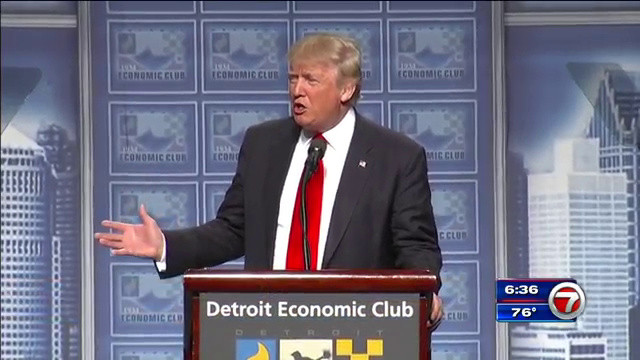NEW YORK (AP) — Donald Trump attached a price tag for the first time Thursday to an economic vision promising what many economists say is impossible: lower taxes, a dramatic expansion in some federal programs and a slimmer government running a smaller deficit.
In a speech to the Economic Club of New York, Trump said that his plan — a mix of tax cuts, regulation elimination and new spending — would reduce the nation’s tax burden by $4.4 trillion over 10 years and create 25 million new jobs.
Trump and his advisers say that would lead to booming economic growth of as much as 4 percent a year, which would make up for most of that lost tax revenue along with an infusion of new money from trade, energy and regulatory reforms.
The rest would come from almost $1 trillion in spending cuts made over the next decade, which Trump would accomplish by cutting one penny from every dollar from certain segments of the government each year.
“My plan will embrace the truth that people flourish under a minimum government burden and will tap into the incredible, unrealized potential of our workers and their dreams,” Trump said.
For Trump’s plans to succeed, they would have to overcome forces in the economy, such as rising automation, an aging population and low-wage competition overseas, that have led even conservative economists to call 4 percent growth an improbable goal.
The U.S. economy is already creating 2.5 million jobs a year, the same pace promised by Trump over the next decade.
Earlier in his campaign, Trump proposed a $10 trillion tax cut over 10 years that was so large and costly that several Republican economists laughed when asked about it. He later tacked on a series of spending proposals that promised even larger deficits, including a push against illegal immigration that analysts estimated could cost up to $600 billion, a $500 billion investment in the nation’s infrastructure and a vow to restore $450 billion of existing cuts in military spending.
“Trump took the budgetary criticism seriously, and made a case that it actually adds up,” said Douglas Holtz-Eakin, who was John McCain’s economic policy director in the 2008 campaign and now is president of the American Action Forum.
Holtz-Eakin said that Trump’s economic plans are now roughly equivalent to those of Democratic nominee Hillary Clinton, at least in scope, namely by proposing several ambitious initiatives and making a plausible, though not necessarily conclusive, argument on how to pay for them.
Others say Trump’s plans are far shakier.
Marc Goldwein, the senior policy director of the nonpartisan Committee for a Responsible Federal Budget, said Trump is “relying on very rosy economic assumptions that I don’t think are going to come to fruition.”
The economy is currently expected to grow by roughly 2 percent a year, and economists say Trump’s proposed restrictions on immigration would be among the many things hampering his ability to double that rate of expansion.
If growth remains around a more realistic 2 percent, Goldwein said, Trump’s plan would add roughly $5 trillion to the nation’s debt. Though Clinton’s tax hikes could slow the nation’s growth, he said, they’d pay for far more of her spending proposals and lead to a deficit a tenth the size of Trump’s.
Trump also vowed Thursday to not cut defense spending and to exempt Social Security, Medicare, and Medicaid from any reductions. Those programs make up two-thirds of the federal budget. That would mean his “penny plan” for reducing spending would likely cut the budget at the heart of some of his signature proposals, including the Border Patrol and Department of Veterans Affairs, said Harry Stein of the liberal Center for American Progress Action Fund.
It would also put Trump in direct conflict with House Speaker Paul Ryan, whose plans for the federal budget, widely embraced by Republicans, call for reining in the costs of programs such as Medicare and Social Security.
Trump also introduced plans for an entirely new federal benefit this week, six weeks guaranteed paid maternity leave. He said he’d pay for that by cutting waste and fraud in the nation’s unemployment program.
David McIntosh, the president of the conservative Club for Growth, hailed the plan, saying it “should be the centerpiece of what he runs on.”
But many economists are skeptical.
“When you look at a lot of these, the theory is nice, but the reality is there’s only going to be a small amount of savings,” Goldwein said of pledges to cut waste.
The heart of Trump’s plan is a revised tax code, which includes a pledge that no business should pay more than 15 percent of its income in taxes, down from the current 35 percent corporate tax rate. Few businesses now pay the full 35 percent rate, taking advantage instead of many deductions in the existing tax code.
He also proposed simplifying the U.S. tax code for individuals, reducing the current seven tax brackets to three: 12 percent, 25 percent and 33 percent of income after deductions.
As president, Trump said he would cut the number of regulations imposed by the federal government, including some that are designed to combat climate change and protect the food Americans eat.
Copyright 2024 The Associated Press. All rights reserved. This material may not be published, broadcast, rewritten or redistributed.

